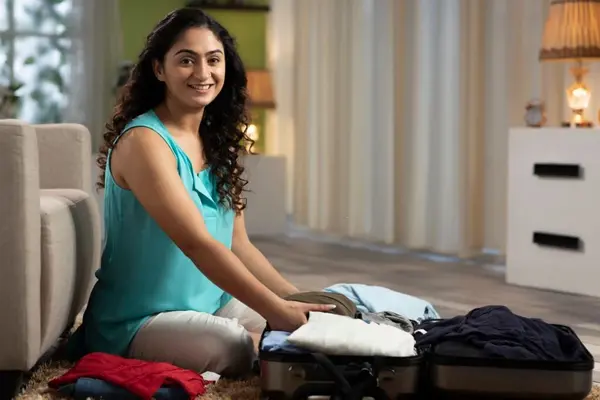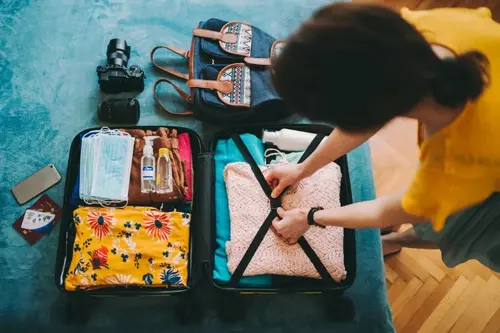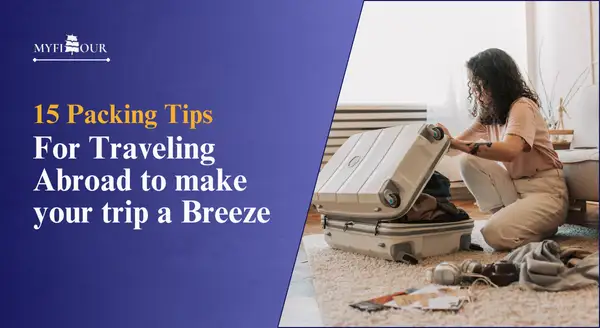International travel can be difficult to pack for. While it’s important to be prepared for anything that can arise, before you leave for a trip, you should check your luggage and be careful not to overpack.
Nobody wants to cover those costs! Let’s look at the checklist for international travel for packing smartly and being well-prepared for your trip.
- Verify that your passport expiration date is more than six months before packing. Several nations won’t let you enter when the expiration date is too soon. Read the local laws for your trip to learn about passport requirements.
- If a travel visa is required, pack one. Before entering, several nations demand a traveler’s visa; also, the length of your stay is frequently limited. Traveling to Europe is simpler for you if you are a citizen of the European Union.
- Make a printout of your travel insurance policy. If you don’t already have one, I urge you to do so because they are typically very inexpensive and offer protection from various risks, including theft, travel delays, and medical expenses.
- Keep your travel papers with you by placing them in a separate compartment or folder. Never check a bag with your documents in it, and constantly keep an eye on them. Additionally, it’s preferable to take photos of them and send yourself a copy in case they disappear.
- Make a copy of your boarding pass to print. If the battery in your phone dies, it will function as a backup.
Also Read: Which transport is better for transport: Private or Public
Table of Contents
Packing Tips for Vacation and Travel Packing Ideas

- Remember to bring your tablet, camera, phone, laptop, e-reader, and earphones. You can leave your camera and tablet behind because your smartphone and laptop can easily replace them.
- Make sure that all of your devices have dual-voltage chargers. Make sure all of your chargers are dual-voltage if you’re an American heading to Europe. The United States uses 110v power, whereas Europe uses 220v. Without a suitable charger, you risk damaging your gadget. Your charger will say something along the lines of “100v-240v.”
- Electronics should never be placed in checked luggage. Use your carry-on or hand luggage instead. Otherwise, they could be lost or broken, and airlines typically won’t pay for goods like electronics.
- Always charge your gadgets before leaving. You may occasionally be required to turn on your gadgets for airport security. Some airlines prohibit passengers from traveling with unusable electronics. The scenario can get worse if you’ve forgotten your charges. Before leaving, be careful to activate Airplane mode.
- Get a power adaptor, please. There are three different types of power adapters available only in Europe. You should study the plugs used in your target nation before making your purchases. There are some worldwide ones as well, which would be a wise purchase if you intend to go abroad frequently.
- Bring a power Bank. An essential item, especially for foreign flights, is a power Bank. Make sure to completely charge all your devices before boarding because they won’t last twelve or more hours while watching movies and television shows.
- Place any liquids larger than 3.4 oz in your checked bag. Liquids in 3.4 oz bottles may be packed in your carry-on, but they must all fit inside a transparent bag that has been certified by the TSA. You must check anything larger you intend to bring with you.
- Leave your shampoos and shower gel at home if you’re staying at a hotel. These are typically free and offered in the bathrooms of hotels.
- You can pack your prescription without risk. According to the TSA, all medications are permitted in checked and hand luggage. However, I would put it in my carry-on bag just in case I needed part of it right away. Additionally, if the drug is in liquid form, weighs more than 3.4 ounces, and is taken appropriately, it is permitted on the trip. Keep in mind that the medication must be in its original container.
- Medications that you might forget include eye drops, motion sickness tablets, painkillers, sunburn lotion, bandages, digital thermometers, diarrhea medications, cough drops, insect repellent, antacids, sleep aids, and anything for allergies.
- You might forget some things: sunblock, face wash, q-tips, makeup, lenses, makeup removal wipes, shaving foam, shavers, hair gel or hairspray, cologne, and dry shampoo. If you’re staying in a hotel, leave these items at home.
- Don’t forget to bring the prescriptions with you if you need to buy prescription medication. Bring a prescription with you in case you need it because some nations will take them.
- Place your medication in a unique, portable pouch. Since you never know when you’ll need something, it’s preferable to be able to locate it quickly than to have to reorganize your entire bag.
Packing Tips for Long-term Travel
Also Read: Checklist for International travel for Packing

- Before your travel, download e-books, films, and TV shows; the flight will last a while—typically up to twelve hours. Ensure that you download it all in advance to keep yourself amused. Time will pass more quickly!
- Put together a comfortable travel kit. Do you believe that 10 hours of sitting in one place will be comfortable? Well, reconsider because you’ll probably feel stiff and worn out after your flight. Pack a pair of sneakers, a hoodie, some plush socks, a face mask, and a sleeping pillow if you have the space for them for a restful night’s sleep.
- Bring items that will enable you to feel more private on the plane. Who you’re going to be sitting next to is always a surprise. You can be seated next to a person who wants to chat the entire flight or prefers to watch movies on a big screen. Pack earplugs, a face mask, and noise-canceling headphones in advance.
- Keep some hand cream and wet wipes in your carry-on for a quick freshening. Wiping your hands and face using wet wipes will leave you feeling a lot fresher even when it is not required. You can feel as though it has been days since your last shower due to the dry air and pressure variations.
- Opt for glasses over contacts. It is practically hard to fly with contacts for more than one or two hours. It most likely has something to do with dryness and pressure shifts. Therefore, place your contacts in your luggage and opt to wear your spectacles.
Tips for Packing Clothes for Travel
Also Read: How to Prevent Motion Sickness While Traveling?
- Whenever two possibilities are comparable, pick the lighter one. I never go without my large, cozy, black sweatshirt. I choose a thinner one because it is less bulky and warm. The same is true for shoes versus boots.
- Bring fewer items and wash things halfway through lengthier journeys. Larger hotels frequently offer this service, which is ideal for trips lasting two to four weeks. Even if they don’t, ask about it; most people will be able to direct you to the closest laundromat. As an alternative, socks and underwear are simple to wash in the sink with ordinary soap. Just be sure to do it in advance, so you have time to hang the clothes to dry!
- Layer your clothing. Dressing in layers is a great way to save space if traveling to a cooler region. Take several thin shirts rather than bulky coats and hoods.
- Wear the heaviest clothing and footwear possible on your flight. You’ll make some room in your suitcase by doing this. Once you’re aboard the plane, you can remove something.
- Pick a color scheme, number 25. Ideally, you should be able to put together an ensemble from any two items of clothing. Packing daily clothing that can’t be worn separately is not recommended. In this manner, you can alternate between changing your t-shirts and undies each day and wearing your pants for a few days.
- You should just bring one outfit for the days you are flying. Pack for six days rather than seven, as you’ll wear the same thing on your initial and final days of travel. Do you really care how you appear on a plane?
- Learn about the fashion scene where you’re traveling. For instance, if you’re a lady in an Arabic country, you shouldn’t wear something that exposes a lot of skin. People dress a little more formally in Europe than in America. Pack your bags accordingly.
- Socks and underwear: Bring only half for longer journeys, and wash everything halfway through.
- T-shirts You can carry one every day because they don’t take up much room when rolled.
- Jackets, tees, and hoodies. While traveling to warmer regions, a thin shirt and a single hoodie will do. You could bring one for every three days in colder climates. One garment should be enough; other jackets take up a lot of room.
- Dresses are ideal for travel because they take up so little room. Just be careful not to overpack and don’t forget to bring some pants for outdoor sports and treks.
- Suits and business attire. Suits and other formal attire are a need when traveling for business. Don’t forget to pack a suit or dress, ties, high heels or other formal shoes, and other accessories.
Packing Tips for Travel with Toddlers
Most individuals detest the idea of traveling with infants and young children under the age of five. I mean, duh! Given that sometimes it seems like you’re transporting your entire house because of all the extra items you need for toddlers and small children, the packing list can get very large. And now that I know from experience that whatever you neglect to pack while traveling with children, you will undoubtedly need that the most, I am compiling a thorough packing list here to assist you. In addition to your belongings, the newborn may require the following:
- Diaper bag
- Extra diapers may be necessary, depending on your destination.
- Wet wipes
- A new bedsheet
- blankets: two minimum
- bags made of disposable plastic
- Disinfectant/Sanitizer
- liquid hand sanitizer for you
- Small packs of children’s amenities, such as toothpaste and brushes
- Tissues
- Small books and toys – Choose their favorites.
- One outfit for the day and in cold weather conditions, always wear layers of clothing instead of just one heavy sweater or jacket.
- Clothes, socks, and shoes according to the season. To determine whether there are enough layers, look at the baby’s hands and nose tip. The baby shouldn’t feel overheated either.
- If the baby is under one-year-old, hats, mittens, and boots are all important.
- Washable bibs, towels, and bathing suits
- Sunscreen and hats
- feeding utensils: portable
- Bring snacks and any prescribed supplements or formulas.
- Your child’s doctor may be able to give you a list of the prescriptions you should bring for the child depending on his or her age.
- Consider child-proofing your space, or bring painter’s tape or socket covers to cover the switches.
- A car seat is a necessity if you are driving alone.
- Stroller: Convenient and simple to fold
Packing Tips for Winter Travel
Let’s start with two fundamental packing light guidelines before moving on to the packing list. When you’re getting ready for a winter trip, four of the seven secrets of packing light take precedence.
Layer Your Packing, Not Bulk
Pack first in layers rather than bulk. Sweatshirts and heavy sweaters can take up a lot of room in your suitcase. Dress in insulating, lighter layers. Consider wearing thin sweaters, long-sleeve t-shirts, and base layers. The different layers will fit more wardrobe alternatives while taking up less room in your backpack. This method was extensively covered in our post on how to pack for an international vacation.
Wear It If It’s Bulky
Put on your bulkiest clothing next. Imagine you have a thick sweater you adore and want to bring with you on your trip. That’s alright. However, you should only pack one and wear it when flying. Your heaviest items should be worn, not packed. That garment will take up less room in your luggage if you wear it rather than pack it. Of course, your winter coat falls under this as well. Even if you don’t intend to wear it the entire flight, wear it aboard the plane. When you feel warm, take it off and store it in the overhead compartment.
Bring only your smallest pair of shoes.
If you’re traveling in the winter and plan to engage in outdoor activities, you may want to pack a pair of snow boots to ensure your feet are toasty. Put your boots on. Avoid packing them. If the second pair of shoes is necessary, make sure they are lighter and smaller than your boots. Pack those shoes.
Wear the Correct Materials
In more severe conditions, it’s crucial to wear high-performance materials, synthetic or natural. Wool has a high warmth-to-weight ratio, so wear it in the winter. Because of its ability to regulate temperature and fight odors, merino wool is known as “nature’s performance fabric.” Perhaps you already have a wool sweater. Merino wool is advised for base layers and socks.
Fill Your (Packed) Shoes with Small Items.
If you’re carrying more than one pair of shoes, store gloves, stockings, and other small items in the second pair.
Utilize packing cubes and compression sacks
Pack your winter travel attire in compression packs or packing cubes to save room for other items.
Travel Packing Tips for Women
Accessories, shoes, and clothing
No matter where they are going, most seasoned travelers bring the same basic clothing. Of course, you’ll add warmer items if you’re traveling in the winter. You’ll also switch out your slacks for a sundress in a warm climate. However, your luggage essentials don’t vary all that much from a trip to trip. Layer up and concentrate on what you want to wear.
Cosmetics and toiletries
When traveling, you should also streamline and reduce the size of your cosmetics, toiletries, and beauty goods. Transform larger bottles into portable containers. Replace liquids with TSA-friendly, more portable bars, and powders. Stick to the basics, even if you enjoy wearing cosmetics and have a multi-step skincare regimen.
Take into account travel-specific underwear.
It’s important to consider what you wear underneath your foundation layer. Perhaps you’ll pack the same pair of underwear at home, but perhaps you’ll choose certain items specifically for the trip. Prioritize comfort while choosing underwear, but also make sure that they dry and wash easily. It’s harder with bras. Wear the item that is most difficult to pack for the flight. Then, think about how you’ll pack the remainder.
Even if it’s difficult, keep your shoe collection to two pairs.
Even the most skilled packers occasionally get stuck on shoes. Why is it so difficult to resist adding a third or fourth pair? Guys indeed have it simpler in this area. Compared to men, we women have a wider variety of shoe needs and options.
Pack Jewelry to Prevent Tangling
First off, leave the family heirlooms behind. Avoid taking a chance by traveling with your most priceless items.
Create Travel-Friendly Makeup
Making your makeup portable is difficult. The TSA prefers dry goods. Decanting is the greatest technique to take just the right amount of moist materials. For a tiny dab, contact lens casings are excellent.
Also Read: Do’s and Don’ts while traveling for first time
Alternatives to Traditional Female Hygiene
Although dealing with your traveling periods is unpleasant, it is common for most of us. How do you manage the discomfort and the mess when you don’t have the amenities of home? Fortunately, there are several possibilities, including:
- Reusable panties
- Sea sponge
- Menstrual hygiene cup
- Reusable tampons and pads
Frequently Asked Questions (FAQs)
Q1. What is the best way to pack when traveling?
Ans: Although it would seem the most sense to fold your clothes, rolling saves almost twice as much room! Start with your bulkier apparel, like pants and coats, and finish with your more casual attire, such as t-shirts and tank tops. You won’t regret using this advice while packing for your subsequent trip.
Q2. What should you not bring when traveling?
Ans: Carry just essential electronics; avoid carrying unneeded items. Jewelry can add to the weight of your bags, so avoid packing it.
Q3. How do you know if you overpack?
Ans: If your bag weighs more than 15kg or 33lb, chances are you’re overpacking.
Q4. What should I pack for a 2-year-old on a plane?
Ans: You could pack some
crayons and activity/coloring books.
Coloring and activity books are a simple way to pass the time on a plane
diapers or pull-ups
toddler headphones
new small toys
snacks or drinks on an aircraft are entirely normal.

